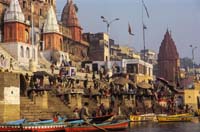 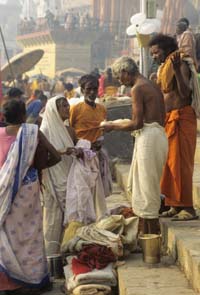 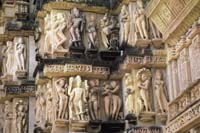 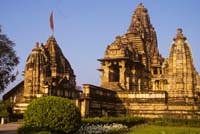 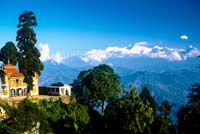 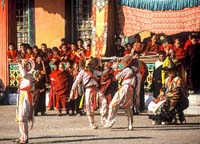 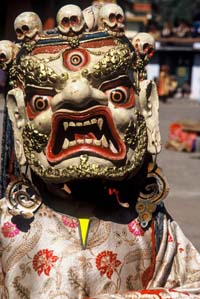  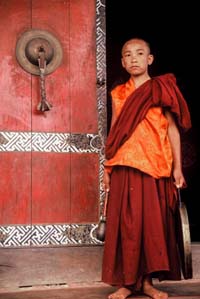    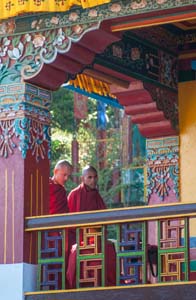 |
GODS, KINGS, AND SAGES OF INDIA Day 1 – Delhi to Darjeeling A morning departure on Indian Airlines will take you to the Bagdogra airport at the foot of the Himalayan mountains. Leave the great Indian plains behindas you rapidly gain altitude while driving up the steep and winding road, through flickering teak forests and lush tea plantations. Soon, Mt. Khanchenjunga, the 28,200 foot “King of Mountains”, dominates the northern horizon, its massive white summit brilliant against the indigo skies. At an altitude of 7400 feet, Darjeeling was developed by the British as a “hill station”, home to the government officials when the plains were broiling in the summer heat. This delightful Victorian hideaway spills down the side of a hill, framed by the awesome Himalayan mountains. This is the perfect place for walks in the foothills with fabulous Himalayan vistas as a backdrop. Take it easy in the afternoon to adjust to the altitude. N.B. If you do not already have the Inner Line Permit for Sikkim, you can get it easily at the bagdogra airport. It’s free but you need 2 photos and a copy of your passport. Day 2 – Darjeeling Early to rise this morning to watch the sun rise over the Himalayas from the view point at Tiger Hill. Khanchenjunga, the third highest mountain in the world, is certainly one of the most impressive, and sunrise here is a spectacle not to be missed. The name Khanchenjunga means “Mountain of the Five Treasures”, and it is sacred to the Buddhists who believe that the jewels to finance the coming age of Shambhala are hidden under its peak. On the way back to town, stop off at the charming Yiga Choling Monastery to see the statue of the Buddha Maitreya, the Buddha of the future. Then board the famous old British “toy train” for the ride back to town. Darjeeling’s claim to fame, of course, is its special brand of delicate and aromatic tea. Known as the “Champagne of Teas”, it is always the most expensive on the world’s wholesale block. The Happy Valley Tea Estate, one of the largest plantations here, can be visited for a hands on look at tea production. Darjeeling was home of the late Tenzing Norgay, one of the first two men to reach the summit of Mt. Everest. His mountaineering Institute here contains a wealth of mountaineering memorabilia, fascinating maps, and old photographs. Day 3, Darjeeling to Gangtok Once virtually inaccessible, Sikkim was an officially Buddhist kingdom until it became part of India in 1975. A unique tradition of Vajrayana Buddhism sets the mood here. Graceful prayer flags, fabled monasteries, incense, and chanting monks give this whole area and aura of mystery. After arriving in the capital city of Gangtok, you might want to visit the Enchay Monastery, whose name means “Place of Solitude”, so designated from its earlier days as a Buddhist hermitage. Close by is the internationally acclaimed Institute of Tibetology. This renowned library contains 28,000 Buddhist manuscripts, making it the largest collection in the world. Priceless icons, ritualistic items, and rare thankas complete this dazzling collection. Day 4 – Gangtok Rumtek Monastery, just outside Gangtok, is the seat of the Kargupa sect in India. Built by the late 16th Gyalwa Karmapa in 1976, this is a replica of the now destroyed Tolung Tsurpu Monastery in Tibet. This is one of the largest and most active monasteries in India with over 100 monks in residence and it has some of the most beautiful frescos to found outside of Tibet. The enormous and elaborate reliquary stupa of the 16th Karmapa is plated in gold and embellished with chunks of turquoise and coral as big as a fist. You can spend some time here and be back in Gangtok in time for some shopping or sightseeing. Day 5 – Gangtok to Kalimpong For centuries, Kalimpong has been a meeting place for Tibetan, Sikkimese, Nepalese, and Bhutanese traders and a walk through the colorful Saturday Bazaar is a walk through the cultural history of this area. Countless varieties of teas, spices, yak cheese, and textiles evoke memories of time when caravans rested here after the arduous trek across the Himalayas. Kalimpong today is a picturesque and peaceful town with charming British cottages and a reputation for the best climate in the area. After lunch, visit the Zang-dog-palrifo-brang Monastery, unusual in that it is associated with the Bhutanese Drukpa tradition of Buddhism. Day 6 – Sunday: Kalimpong to New Delhi It’s a beautiful drive back down the hill to the Bagdogra airport for your afternoon flight back to New Delhi. Overnight in Delhi. Day 7 – Delhi to Agra The Shatabdi Express, India’s most modern and comfortable train, pulls out of the New Delhi train station early in the morning for the short ride to Agra. When you arrive in Agra. you might want to have a driver meet you to take you out to Fatehpur Sikri, the haunting red sandstone city built by the Mogul emperor Akbar in 1569 to house some 200,000 people. This regal ghost town is an exquisitely preserved example of the best of princely opulence. Palaces, mosques, huge bathing pools, and stables for his 30,000 horses were intricately and painstakingly carved from sandstone as if it were mere wood. It will take a few hours to walk around. Return back to Agra, perhaps to take in the tomb of Empress Nur Jahan’s father, Itmad-ud-Doulah. This exquisite little gem was built ten years before the Taj Mahal and incorporates many of the same Persian design elements such as the pietra dura style of inlay seen here in flowing arabesque designs. Sunset is one of the best time to visit the Taj Mahal, that prize of Indian architecture that defies the imagination and leaves one speechless in the face of its tremendous size and power of artistic expression. Twenty two years in the making, this monument to his greatest love – his wife Mumtaz Mahal – is a culmination of Shah Jahan’s passions for architecture, jewels, and poetry. The entire surface, inside and out, is inlayed with semi-precious stones and some of the flowers have 50 separate pieces of stone, so perfectly set that it is impossible to find the seams. Day 8 – Tuesday: Agra to Khajuraho You might want to return to the Taj for sunrise. After breakfast, explore the enormous Agra Red Fort, seat of the government during the reigns of Akbar, Jahangir, and Shah Jahan. Literally a city within a city, its size and ostentation was intended to affirm the power and glory of the great Mogul empire. Shah Jahan died here, a prisoner of his son, and we can visit his quarters where he spent his last years gazing wistfully out at the tomb of his beloved Mumtaz Mahal. A short afternoon flight takes you to Khajuraho and after checking into your hotel, take some time to look around this quiet and traditional small town. Day 9 – Khajuraho to Varanasi The 85 temples of Khajuraho were built during the short span of 100 years in the 11th and 12th centuries when Tantracism flourished in northern India. These quintessential Indo-Aryan temples are the most refined and best preserved in northern India. This morning set off to visit a few of the remaining 22, some of them decidedly erotic to symbolize and glorify the creative life force known to the Hindus as “Shakti”. Each one of these ornately carved ancient temples depicts courtly as well as everyday life during that time. Perfectly carved friezes of elephants and tigers carry goddesses, celestial nymphs, and princesses up and down the sides of the temples, and voluptuous royal maidens instruct us in the latest make-up techniques. Later in the afternoon, catch a flight to Varanasi. Day 10 – Varanasi Indian mythology tells us that Varanasi (also known as Benares) is the oldest of all cities and that may not be far from wrong. Archeologists place its founding at about 4000 years ago when it was known as Kashi, the “City of Light”. Since the dawning of recorded history, throngs of devotees have come here to purify their souls in the holy waters of the Ganges river and gain release from Samsara, the endless cycle of birth, death, and re-birth. At sunrise, you can board boats to float quietly past this ancient and sacred ritual which takes place every morning along the stone steps called “ghats”. It is believed that the Lord Shiva once lived in Varanasi, and this city is dedicated to him. Walk through the crowded cobblestone alleyways, filled with pilgrims and saddhus, and visit few of the beautiful temples built in his honor. Later in the day, you can have your driver take you to Sarnath, the deer park where the Buddha gave his first sermon, known as the “Turning of the Wheel of the Law”. The excavated ruins here include several stupas set in a peaceful and tranquil garden, and the museum has perfectly preserved examples of sculptures from this site as well as the Ashokan lion capital which is now the national symbol of India. In the evening, return to the riverbanks for the evening aarthi ceremonies. This is a newly invented tradition, but it is beautiful never the less. Set your tiny basket of flowers and a candle afloat down the currents of the Ganges river as the sun sets. Day 11 – Varanasi to New Delhi This is a renown city of learning, home to philosophers, scholars, and poets. Even the ancient tales of the Ramayana and Mahabharata speak of this enclave with respect. You might want to check out the Sanskrit University. A center for classical Sanskrit studies, this beautiful tree shaded campus has a museum which houses a superb collection of miniature paintings. Varanasi is also the home of sitarist Ravi Shankar and is still a center for sitar production. Magnificently crafted sitars can be purchased here very reasonably. Dazzling silk brocades, once so coveted by the people of the Roman Empire, made this city famous throughout the ancient world. It is fascinating to watch the production of these fabrics called “Kinkhib”, some woven with threads of pure silver or gold. A late afternoon flight will return you to Delhi. |
